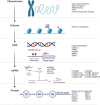Advances in the pathogenesis and clinical application prospects of tumor biomolecules in keloid
- PMID: 35769828
- PMCID: PMC9233200
- DOI: 10.1093/burnst/tkac025
Advances in the pathogenesis and clinical application prospects of tumor biomolecules in keloid
Abstract
Keloid scarring is a kind of pathological healing manifestation after skin injury and possesses various tumor properties, such as the Warburg effect, epithelial-mesenchymal transition (EMT), expression imbalances of apoptosis-related genes and the presence of stem cells. Abnormal expression of tumor signatures is critical to the initiation and operation of these effects. Although previous experimental studies have recognized the potential value of a single or several tumor biomolecules in keloids, a comprehensive evaluation system for multiple tumor signatures in keloid scarring is still lacking. This paper aims to summarize tumor biomolecules in keloids from the perspectives of liquid biopsy, genetics, proteomics and epigenetics and to investigate their mechanisms of action and feasibility from bench to bedside. Liquid biopsy is suitable for the early screening of people with keloids due to its noninvasive and accurate performance. Epigenetic biomarkers do not require changes in the gene sequence and their reversibility and tissue specificity make them ideal therapeutic targets. Nonetheless, given the ethnic specificity and genetic predisposition of keloids, more large-sample multicenter studies are indispensable for determining the prevalence of these signatures and for establishing diagnostic criteria and therapeutic efficacy estimations based on these molecules.
Keywords: Biomarkers; Epigenetics; Exosomes; Keloid; Proteome; Tumor biomolecules; Tumor signatures.
© The Author(s) 2022. Published by Oxford University Press.
Figures


Similar articles
-
Genetics and Epigenetics of Keloids.Adv Wound Care (New Rochelle). 2022 Apr;11(4):192-201. doi: 10.1089/wound.2021.0094. Epub 2021 Dec 27. Adv Wound Care (New Rochelle). 2022. PMID: 34498914
-
Epithelial-mesenchymal transition in the formation of hypertrophic scars and keloids.J Cell Physiol. 2019 Dec;234(12):21662-21669. doi: 10.1002/jcp.28830. Epub 2019 May 20. J Cell Physiol. 2019. PMID: 31106425 Review.
-
Epithelial-mesenchymal transition in keloid tissues and TGF-β1-induced hair follicle outer root sheath keratinocytes.Wound Repair Regen. 2015 Jul-Aug;23(4):601-10. doi: 10.1111/wrr.12320. Epub 2015 Jul 14. Wound Repair Regen. 2015. PMID: 26036684
-
Partial epithelial-mesenchymal transition in keloid scars: regulation of keloid keratinocyte gene expression by transforming growth factor-β1.Burns Trauma. 2016 Aug 23;4(1):30. doi: 10.1186/s41038-016-0055-7. eCollection 2016. Burns Trauma. 2016. PMID: 27574697 Free PMC article.
-
The epigenetics of keloids.Exp Dermatol. 2021 Aug;30(8):1099-1114. doi: 10.1111/exd.14414. Epub 2021 Jun 30. Exp Dermatol. 2021. PMID: 34152651 Review.
Cited by
-
The effects of systemic diseases, genetic disorders and lifestyle on keloids.Int Wound J. 2024 Apr;21(4):e14865. doi: 10.1111/iwj.14865. Int Wound J. 2024. PMID: 38584345 Free PMC article. Review.
-
Insights into the role of adipose-derived stem cells and secretome: potential biology and clinical applications in hypertrophic scarring.Stem Cell Res Ther. 2024 May 12;15(1):137. doi: 10.1186/s13287-024-03749-6. Stem Cell Res Ther. 2024. PMID: 38735979 Free PMC article. Review.
-
BUB1B promotes cisplatin resistance in gastric cancer via Rad51-mediated DNA damage repair.Transl Oncol. 2025 Apr;54:102334. doi: 10.1016/j.tranon.2025.102334. Epub 2025 Mar 7. Transl Oncol. 2025. PMID: 40056529 Free PMC article.
-
Orthogonal upconversion supramolecular microneedles promote endogenous ferroptosis in keloids.Theranostics. 2025 May 8;15(13):6184-6202. doi: 10.7150/thno.108289. eCollection 2025. Theranostics. 2025. PMID: 40521195 Free PMC article.
-
Therapeutic role of exosomes and conditioned medium in keloid and hypertrophic scar and possible mechanisms.Front Physiol. 2023 Sep 12;14:1247734. doi: 10.3389/fphys.2023.1247734. eCollection 2023. Front Physiol. 2023. PMID: 37781228 Free PMC article. Review.
References
-
- Macarak EJ, Wermuth PJ, Rosenbloom J, Uitto J. Keloid disorder: fibroblast differentiation and gene expression profile in fibrotic skin diseases. Exp Dermatol. 2021;30:132–45. - PubMed
-
- Al-Attar A, Mess S, Thomassen JM, Kauffman CL, Davison SP. Keloid pathogenesis and treatment. Plast Reconstr Surg. 2006;117:286–300. - PubMed
-
- Park TH, Park JH, Tirgan MH, Halim AS, Chang CH. Clinical implications of single- versus multiple-site keloid disorder: a retrospective study in an Asian population. Ann Plast Surg. 2015;74:248–51. - PubMed
Publication types
LinkOut - more resources
Full Text Sources

